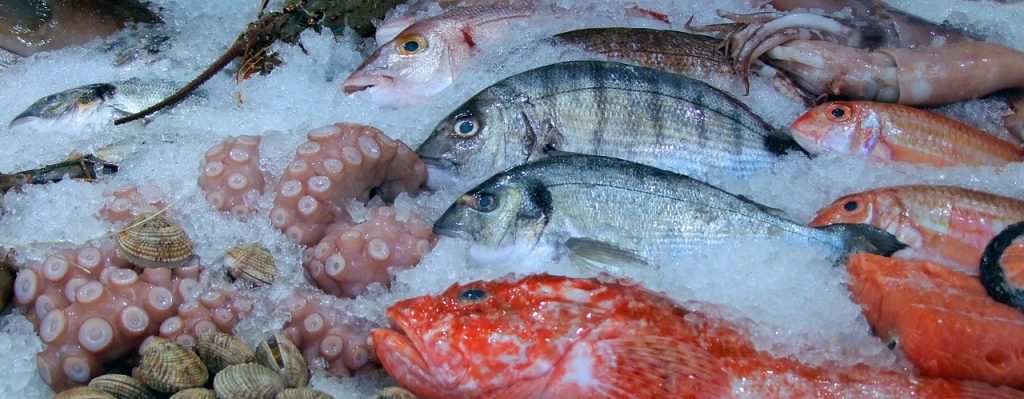How to buy fresh fish?
Fresh fish is attractive in appearance, with shiny skin covered in transparent, water-clear mucus. The eyes are clear and firm and the smell is species-specific, but in general freshwater fish have a pleasant lakeside smell, while marine fish have a pleasant seaside smell. Freshness is further indicated by the condition of the gills, which are also species-specific, ranging from bright red to deep burgundy. The flesh of fresh fish is always flexible, and the body of the fish is rigid.
In the case of mussels and oysters, freshness is indicated by the animals being alive. This can be checked by checking that the shell of the mussel or oyster is tightly closed. Occasionally, the shell of a mussel or oyster will open a little, but the live animal will close the shell again when touched. If this is not the case, the mussel or oyster should not be eaten!
Although there is a common belief that fish meat spoils very quickly, nowadays, when households have fridges and new processing technology allows fish meat to be cooled quickly, this is not necessarily true. Generally speaking, fish meat can be stored safely for 5 to 14 days at a temperature of 0 to +2°C on ice, depending on the species. Of course, there are a few rules that must be followed to ensure that fish meat is safe to eat!
How long will our fish keep?
Freshwater
- Freshwater herbivorous species typically have a shorter shelf life, with a recommended maximum storage time of 3-4 days packed in melting ice.
- Freshwater carnivorous species such as trout, bass, catfish, pike, etc. can be stored in melted ice for up to 7-12 days depending on the species.
Marine fisheries
Fish species from marine fisheries can be safely stored in melting ice for 5-21 days depending on the species:
- Bluefish mackerel, sardines and herring halves 5 days.
- Cold-water species, salmon halves, noble white fish 9-14 days.
- Tropical white fish 12-14 days.
- Aquaculture species 14-16 days.
- Certain large fish species such as tuna, and halibut 18-21 days.
The above shelf-lives always apply to the whole fish; if the fish has been cut and filleted, only 2/3 of the shelf-life should be taken into account!
How do we store fresh fish?
- Always store fresh fish between ice!
- Ice should be changed every day on fresh fish!
- The storage container/box should always be designed in such a way that the melted water and fish slime produced when the ice melts should NOT come into contact with the fish! If you are lucky, you can place a perforated insert in the bottom of the box, spread the ice on it, lay the fish on it and cover it again with ice. This way, the melted ice and fish slime will flow through the perforated insert and collect at the bottom of the storage box, separated the clean ice and fish
- In any case, fresh fish bodies and fillets should only be stored with the ice in contact with the skin of the fish, the surface of the cut fish meat should be covered with plastic film or greaseproof paper and only then covered with ice!
- In the case of wild-caught fish, we can only estimate the expected shelf life in all cases, because the exact time and circumstances of the catch are typically unknown.
- Fresh tuna fillets should preferably be stored wrapped in greaseproof paper in the refrigerator.
- Shellfish and oyster halves should be stored between +2 and +4°C, if possible, ensuring a balanced humidity. Cover the mussels or oysters with a damp kitchen towel. Also store the shellfish in such a way that the leachate is allowed to collect under the box, separated so that it can be emptied daily.
- NEVER try to keep live crustaceans in water under house keeping conditions, or even in salt water for marine crustaceans, as they are guaranteed to die in a short time! The correct storage method is +2 – +4°C, covered with a damp kitchen towel. If the crab dies, it can be safely used within 24 hours by placing it in ice immediately, as with whole fish.
How do I prepare fish meat for frying-cooking?
After scaling and gutting, fresh, whole fish can be briefly washed under running water, but then wiped dry inside and out with a clean paper towel. Fish fillets should not be washed in water before preparation, preferably only wiped dry with dry, clean paper towels! Thick, loose white fish fillets such as cod should be soaked in ice water with 5% salt for 20-25 minutes before preparation, then rinsed in cold tap water and wiped dry with absorbent paper towels, then wrapped in paper towels and left to rest in the fridge for 5 minutes! To “debone” the flesh of freshwater fish with splinters, lay the fish fillet with the skin side down on the cutting board, then score the flesh at 3-4 mm intervals perpendicular to the length of the fish fillet, cutting through the flesh to the skin (deboning).
Last updated: September 24, 2023



Comments are closed.